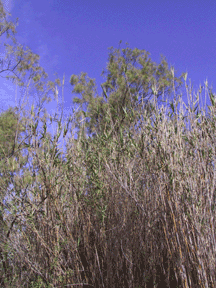Vertebrate invaders include cowbirds,
nest parasites that affect the Least Bell’s
Vireo, and house cats. Other invaders
not in the reserve but in California represent
serious threats. These include the “killer”
alga Caulerpa taxifolia, the salt-marsh
destroying isopod Sphaeroma quoyanum,
the cordgrass Spartina alterniflora, the
green crab, and the red fox. Given the
many problems associated with exotic species,
the current efforts expended by reserve
staff to combat these species, and the
continuing threat of new invasions, we
are in the initial stages of developing
a comprehensive invasive species management
plan. This plan will encompass both terrestrial
and aquatic ecosystems, and will provide
a valuable framework for understanding
and managing invasions at the reserve.
In addition, as this represents one of
the first such efforts in the nation,
our plan will hopefully serve as a model
for other estuaries attempting to deal
with problems associated with biological
invasions.
The
invasion of large plants and trees are
often of particular concern, as they have
the potential to change the very nature
of the ecosystem itself. In the Tijuana
River Valley, several ecosystem-altering
invaders have become very abundant. These
include tamarisk (or salt cedar), the
giant reed Arundo donax, and castor bean
(which is also toxic).
The
initial stages of this ambitious project
have consisted of determining the extent
of invasion of these three plants in the
river valley, as well as identifying demonstration
sites that will be used to assess the
best methods of invader control. The results
of these efforts, coupled with other available
information, will then be used to develop
a comprehensive invasive species management
for the Tijuana River Valley. Through
this, we hope to stem the tide of invasion
and facilitate the recovery of native
species in this sensitive and threatened
ecosystem. |

Arundo

Click Here for Additional Information
|